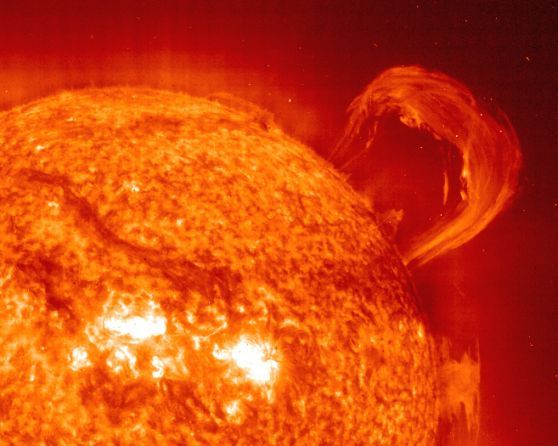Periodically our sun blasts streams of hot, ionized gas into the solar system. These eruptions, called coronal mass ejections or CMEs pose a potential threat to astronauts or satellites if aimed at Earth. On April 9, the Sun erupted with a CME, and because the eruption was located on the edge or limb of the sun, it was observed in unprecedented detail by a fleet of spacecraft, revealing new features that are predicted by computer models but are otherwise difficult to see, even for specialized sun-watching spacecraft. From these observations, astronomers have been able to create an animation of this spectacular event.
When a CME occurs, usually spacecraft watching the event need to protect themselves from the bright X-ray solar flare associate with a CME. However, since the April 9 CME occurred on the edge or limb of the Sun as viewed from Earth, the solar flare was hidden from view, which allowed spacecraft to take longer exposures and uncover fainter structures than usual.
“Observations like this are very rare,†said Smithsonian astronomer Ed DeLuca.
Using the Smithsonian-developed X-ray Telescope (XRT) aboard the Japanese Hinode sun-watching satellite, astronomers saw a spiral (helical) magnetic structure unwind as it left the Sun during the CME. Such unwinding can release energy as the magnetic field goes from a more twisted to a less twisted configuration, thereby helping to power the eruption.
Hours later, XRT revealed an inflow of material toward a feature that appears as a bright line—actually an object known as a current sheet seen edge-on. A current sheet is a thin, electrified sheet of gas where oppositely directed magnetic field lines annihilate one another in a process known as magnetic reconnection. The extended observations from XRT show that magnetic fields flow in toward the current sheet for many hours after the eruption, progressing first toward the sheet and then down to the sun’s surface.
The astronomers were able to create an animation of the event.
They also determined that the temperature of the current sheet is between 5 and 18 million degrees Fahrenheit, which matches previous measurements higher up in the corona by the Ultraviolet Coronagraph Spectrometer on the SOHO spacecraft.
Astronomers study these explosions in hope of being able to predict them and provide “space weather†forecasts.
Original News Source: Harvard Smithsonian Center for Astrophysics



“the temperature of the current sheet is between 5 and 18 million degrees Fahrenheit”
Surprisingly this looks like it was converted and rounded off from Celsius/Kelvin since 18 million °F is 10 million °C/K. Before the press release people got a hold of this article it likely read between 2.8 and 10 million Kelvin or degrees Celsius.
Nancy, could you please ensure that metric measures are included in these postings for those of us who don’t use American or Imperial measures.
Great article. Will try to watch the video